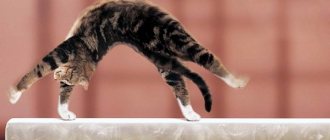When a kitten appears in an apartment, most people teach it to use a litter box, which involves constant cleaning, time and material costs. Therefore, many breeders initially raise their pets differently.
At first glance, it seems that only a trainer can train a cat to use the toilet. In fact, you can do this yourself, just be patient, treat your animal with love, and soon your four-legged friend will please the owner with his first successes.
Wrong opinion
Experts say that it is necessary to accustom your pet to the toilet from infancy, because it is impossible to accustom an adult cat. They also say that a litter box trained kitten will not change its habit. This is incorrect for several reasons:
- for the first six months of a kitten’s life, you cannot accustom it to the toilet, because it will not be able to hold steady, it will get scared and will avoid this place;
- first, accustom the pet to the tray;
- Even an adult cat can be toilet trained.
Each animal has its own character, one is easy to train, the other, due to fear and apprehension, needs more time to get used to. The approach to each kitten should be individual, but the principle of training is no different. First, you need to teach your pet to masterfully use the litter box.
Benefits of using a toilet instead of a litter box
Why train an animal to use the toilet, when to maintain cleanliness in the house it is enough to regularly change the cat's litter box? On the one hand, this is true. But if you look at the benefits of letting a cat use the toilet, it becomes obvious that this method of organizing a cat’s litter box is much better. It has a number of advantages:
- There is no need to look for a convenient place for the tray so that it does not interfere or catch the attention of guests.
- No unpleasant odor. It is unlikely that the owner will clean up after the cat immediately after filling it, so the presence of an unpleasant odor, albeit temporarily, will always be present.
- Saving time on cleaning the cat litter and regular disinfection.
- Cleanliness – the toilet tray for cats has a very modest size, and no matter how clean the cat is, granules or sand will always be scattered around the tray.
- Money savings - cat litter costs money, and in order to maintain cleanliness in the tray, it is recommended to change the granules as often as possible, and this, accordingly, is a constant waste of money.
And of course, what owner of a mustachioed pet would not be pleased by the enthusiastic cries of the guests watching how the smart cat not only went to the toilet, but also flushed after himself.
Let's start with the tray
It is necessary to accustom your baby to the tray from the first days after birth. Kittens have a peculiarity - they defecate immediately after eating. If you are patient and make sure that your baby goes to the toilet immediately after eating for several days in a row, then your pet will not have problems with the toilet in the future.
The cat must be handled carefully, without causing pain. When the kitten has eaten, carefully pick it up under the tummy and take it to the tray. If the kitten crawls out of the toilet without emptying itself, it is returned back. After completing toilet chores, the kitten is praised.
The toilet container is placed in a convenient place; sometimes the kitten itself will determine such a place, trying to empty itself there. Then the tray is gradually moved closer to the toilet room.
First, the cat is accustomed to the sound of water pouring out of the cistern. They do this gradually, drain the water with the door open so that the cat hears the noise from afar, then press the drain in front of the animal. While the water is roaring, they hold the cat in their arms, stroke it, say kind words, and show how the water flows.
Instructions for toilet training a cat
In order for the event of retraining a cat from a tray to a toilet to be successful, you must follow strict instructions . The sequence of steps is extremely important.
Training a cat to use the toilet proceeds sequentially
If the tray was not previously in the toilet, then the pet must first be introduced to the earthenware object and accustomed to the noise of the flush cistern. To do this, simply keep the door to the toilet room constantly open, and constant curiosity will lead the cat there itself.
Taking the animal in your arms and sitting on the toilet lid, you can flush the water in the tank a couple of times so that the kitty is not afraid of unusual sounds.
When the pet stops showing signs of anxiety (if any), you can begin to take more decisive action.
Moving the tray to the toilet
This step is only relevant if the tray is located in another room, for example, in the bathroom. The cat potty should be moved to the toilet room and placed next to the toilet. It is recommended to do this slowly, moving the object 2–3 cm every day. Otherwise, the animal may get confused and begin to shit on the floor in the place where the tray was previously located. After the desired is achieved and the cat begins to relieve its needs in a new place, you can proceed to the next step.
Teaching Techniques
The learning process depends on the intelligence of the pet. If something doesn’t work out, they start over from any stage. The speed of learning depends on the age of the cat, its temperament, and character. As soon as the animal has good coordination and stability, training begins.
Reception No. 1
The cat owner should not push the cat out of the toilet room when he himself is there. Some animals are so inquisitive and intelligent that when they watch their owner, they can repeat his actions.
Reception No. 2
Spread the filler along the bottom of the toilet and keep the toilet door open. The cat may become interested in the smell of the litter, jump onto the toilet seat and defecate. However, this method can lead to clogging of sewer pipes, so filler should be poured rarely and in small portions.
Technique No. 3:
- When the kitten is already accustomed to the litter box, move it 5-7 cm closer to the toilet every day. There is no need to rush things; if the animal is nervous, temporarily stop the rearrangement.
- When the tray is in the toilet room, you don’t need to lift it right away - the kitten should get used to the new place.
- As soon as the pet gets used to it and gets comfortable, lift the toilet container up a little every day. For this, old magazines, cardboards, and planks are used. The stands are wider than the container; it must stand firmly, not wobble, or slide.
- During the period of time that the tray is raised, the amount of filler poured is gradually reduced.
- Raise the toilet container to the height of the seat, and slide it onto the toilet seat with one edge.
Gradually move the tray to the edge of the toilet seat more and more so that the cat gets used to it, secure the edges with adhesive tape. Do not put filler on the container's grid; the animal must get used to the fact that there is a smooth base under its paws. As soon as the pet gets used to defecating at the level of the toilet, remove the tray and watch the cat. If he does not settle on the toilet seat, return the tray to its place. Repeat actions until the bitter end.
To make it easier for the cat to jump onto the seat, place a step nearby.
Reception No. 4
They buy a deep container, cut a small hole, and lower it down the toilet. A little filler is poured around the hole, and the hole is gradually cut wider so that the cat learns to stand with its paws along the edges of the side. When he gets used to it, the container is removed.
Reception No. 5
Specialized pet stores sell pads with holes that are securely attached to the seat of the toilet seat. You can make such an overlay yourself from thick cardboard, cover it with soft material and secure it.
The overlay consists of a rim and a central round part, which is fixed to the rim. When the cat learns to defecate with the pad, the central circle is removed. A cat accustomed to the place will already stay well on the headband. After a few days, the rim is also removed.
To attract a cat to the toilet, place a little litter with the smell of cat urine under the rim of the seat. Later it is removed.
Reception No. 6
A hole is cut in the seat cover and a basket with filling poured into it is hung. To prevent the pet's paws from slipping, they are covered with cloth. You can make such a toilet yourself and quickly.
If a toilet-trained pet “puts a pile” in the wrong place, they collect what they’ve done and throw it in the toilet. They lock the animal in the same place for 10-15 minutes - he will soon understand what he did wrong.
After the cat has made its first successful attempts at hiking, immediately hide the toilet container so that it does not smell it. If the pet senses where the smell of its urine is coming from, it will gravitate there, so it is best to take the tray out of the apartment altogether.
Special pads for training a cat to use the toilet
To help their pets adapt to new conditions, some owners use a mesh tray insert. They cut holes along the edges and then tape it to the toilet seat. You can even pour a little filler there at first.
You can make your own plastic mesh cover from a cat potty
But there is no need to make anything; in pet stores you can find special toilet accessories for training cats. Structurally, they look different, but the principle of operation is the same for all. They are an ordinary plastic cat potty that gradually turns into an overlay.
A plastic toilet cover for training cats makes this process easier.
At the first stage, everything happens in the same way as described above, the tray is installed on top of the toilet. But there is no need to clean it up abruptly, because sometimes cats at this stage refuse to do their business correctly and begin to crap in other places.
A new hole is cut out in a special pad every few days.
A specialized pad in which a small hole is first cut out greatly facilitates the habituation process. About once every 5-6 days it is slightly enlarged (cut or broken, depending on the specific model). The cat understands that it is impossible to step into the middle and slowly adapts to the enlarging hole. At its maximum size, when the pet can confidently hold on to the toilet itself, the lining can be removed completely. Using such devices, you can train small cats and even kittens.
By gradually enlarging the hole in the pad, it is much easier to train your cat to use the toilet
There are reusable systems, they are designed a little differently. They include a set of plastic pads with holes of different sizes, which are changed as the animal gets used to it.
Reusable plastic pads are replaced as the cat gets used to the new conditions for relieving itself.
The most popular cat training devices among buyers are: Domakot, Unikot, Vaka, Litter Kwitter, CitiKitty Cat Toilet Training Kit.
When purchasing pads, you must take into account the weight of your pet and the thickness of the plastic of the product. The heavier the cat, the more massive and thicker such a device should be.
Overlay systems
Veterinary stores sell designs that help you easily accustom a cat to the toilet in an apartment. They are produced for animals of all ages - for young kittens and adult cats:
- letter-quitter - a cover made by Chinese manufacturers, made of plastic; following the instructions, you can accustom a cat to the toilet in an apartment in 2 months;
- cat houses - the design is intended for adult animals that are 3-4 months old;
- anti-scratch – Russian-made pad, holes are made by hand.
Purchased pads will allow you to accustom your cat to using the toilet in an apartment in a short time, but after each cat litter you need to wipe them with delicate hygiene products to remove the smell of urine.
The younger the kitten, the better it can be trained.
Second phase
When the cat litter box is located directly next to the toilet, and the pet goes on it without problems, you can proceed to the second stage - raising the cat litter box to the level of the toilet bowl. To do this, you will need several stands or benches with different heights. Every day the tray should rise 5 cm higher, positioning itself closer to the toilet seat.
The toilet lid must always be open. This is necessary so that the cat gets used to this type of toilet. Naturally, a cat's curiosity will always take over, and the pet will definitely look into the toilet.
It is recommended that the owner provide a stand for the tray so that it is strong and stable enough. After all, if a pet falls from such a “pedestal” at least once, the likelihood that he will want to use it again is zero.
When raising the tray higher, you need to carefully monitor the behavior of your pet. Some animals quickly get used to changing the position of the tray, while others may experience some inconvenience. It is important to make sure that the cat does not feel discomfort, because if the animal is constantly uncomfortable, training can be given up.
Pros and cons of cats going to the toilet
Using the litter box is a useful skill for a cat, but it has its positive and negative sides.
Positive
The learning process is entertaining, brings joy and positive emotions:
- every successful stage will be happily discussed by the whole family;
- time will be freed up that was previously spent cleaning the cat litter box;
- no need to spend money on buying new containers and litter for the toilet;
- squeamish pet owners will not be haunted by phantom smells of cat urine;
- There will never be litter scattered on the floor after the kitten has emptied.
The main thing is that when the cat’s toilet training in the apartment is completed positively, it will become a source of pride and something to brag about to friends.
Useful tips
And now the result has been achieved. Your pet successfully does its business on the toilet. Now you need to follow two rules:
- Keep the toilet door ajar at all times so that the cat can easily get in at any time. In some cases, you can cut a special cat hole in the door.
- Never lower the toilet lid. Your pet should always have the opportunity to go to the toilet when he needs it.
You should always praise your pet for correct actions. Cats understand affectionate and encouraging intonations very well.
CitiKity simulator
The essence of this simulator is that it includes plastic in the form of a tray and there are 7-8 sections on it. That is, the question of how to train a cat to pee on the toilet can be resolved in 7-8 weeks. This tray should be placed under the baby cat and covered with cat sand, and then left there for a week.
You need to train the cat to jump in there. After a week, you need to cut out the first section - the smallest circle that is in the middle. The cat continues to get used to walking.
- After a week, cut out even more. Eventually, when there are no sections left at all, you will end up with a healthy hole. Thus, the animal learns to relieve itself in the toilet on its own. If you teach it from two months, it takes about a year and a half.
- The instructions say that you can train from 6 months, but the sooner you do this, the better, because the older the cat gets, the more difficult it is to influence him.
- During this time, there will be cases when the cat will go the wrong way, relieve itself in all corners, for which it needs to be punished. This punishment lasts for a week, after which everything is repeated, but patience is important here.
- Teaching a cat to go to the toilet is not an easy job, but at the same time, it is an opportunity to study his habits, character, and behavior.
In the future, the owner will already know that if a cat, for example, rushes around the apartment and meows loudly, this means that he wants it big. If he starts clinging to the carpet with his paws and spinning around the wall, it means that he wants something small.
Other means
There are also other aids for teaching a kitten to use the toilet in an apartment.
Toilet nozzle
We also recommend paying attention to a special plastic toilet nozzle. This nozzle is a special plastic structure that resembles a tray grid, which is attached directly to the toilet bowl. If you wish, you can place a little litter on top of the grill to make it more familiar to the kitten. This attachment is a worthy alternative to a litter tray and allows a small kitten or small cat to sit comfortably on the toilet without the risk of falling into the water.
Toilet training spray
Even if you have fully followed all the recommendations and gradual training of the kitten to the toilet, your pet may not want to go to the toilet on its own or will periodically leave marks in other places. In this case, you need to purchase a special spray to train the kitten to the toilet. This spray has a specific smell for cats, which makes them want to go to the toilet in a certain place. When training your kitten to use the toilet, try applying a special spray directly to the toilet nozzle or litter that is scattered around the hole in the nozzle.
Currently, the range of products designed to correct the behavior of cats is quite wide:
- Api-San smart spray,
- Beaphar Catty Home,
- Ms. Kiss,
- Himola and others.
Cost of means for toilet training kittens: 150-500 rubles.
Along with the toilet training product, it is recommended to purchase a weaning agent that needs to be sprayed in those places where the cat should not go to the toilet. Before using the weaning agent, the areas to be treated must be cleaned with water and a disinfectant added to eliminate the smell of urine. The range of weaning agents is quite wide: Antigadin, Ms. Kiss “Weaning off shitting”, Api-San “Weaning off shitting” and others. The cost of these funds: 150-300 rubles.
General recommendations
- Pay attention to the material from which the simulators for training your cat to use the toilet will be made. The plastic should be smooth and hypoallergenic, without foreign odors. Since the strong smell of plastic can scare a cat away from the toilet forever.
- If your cat's weight and size are significant, then she may not notice a change in the diameter of the hole by a couple of centimeters. On the contrary, if the kitten is still small, then make sure that you have a spare nozzle in the toilet training kit. In case the kitten gets scared by the rapidly increasing diameter of the hole and needs to take a step back.
- Ensure your cat has unobstructed access to the toilet. Always keep the door to the toilet ajar. Also, do not close the toilet lid. The cat should have access to the toilet at any time, even if you are not at home.
- You will have to clean the toilet using neutral, fragrance-free disinfectants, since cats are extremely sensitive and cannot tolerate strong odors.
- Some owners teach their cats to flush behind themselves using a special pedal connected to the cistern. This may seem like a good idea to you. But be prepared for the fact that a cat that has learned to flush itself will occasionally enter the toilet and press the pedal just to listen to the murmur of water.
- To consolidate the results of a kitten’s training, it is possible to use a reward method. After each trip to the toilet, you should give the kitten a small treat; this approach will allow the correct habit to take root faster.
- Despite all your efforts, your kitten or even an adult cat may simply be afraid of the sounds of the toilet: water filling and flushing. In this case, while sitting on the toilet, take your pet in your arms and stroke it. Then, rinse off the water several times without stopping stroking. Your pet should understand that there is nothing scary about the sounds of the toilet and you can safely use this device.
Please note that toilet training products do not apply to:
- Kittens are younger than 4 months, as they are still too small and can fall into the toilet.
- Pregnant cats because they have difficulty balancing on the edge of the toilet and a fall can cause injury to the fetus.
- Disabled animals, with missing or shortened legs, due to the inability to jump to the height of the toilet and maintain balance correctly.
- Sick animals suffering from diseases of the musculoskeletal system, as well as diseases of the genitourinary system and gastrointestinal tract. If you have problems with urination or constipation, it will be very difficult for your cat to maintain the correct position on the toilet for a long time.
Always remember that training a kitten or adult cat to use the toilet in a certain place is a very long, labor-intensive and responsible process. There's no need to rush. If you fail, do not scold your cat under any circumstances. Be patient and kind to your pet, and then a positive result will not be long in coming.
This is perhaps the first and most pressing question that arises with a new cat. Of course, we can optimistically assure you that no special problems will arise on this issue, but... Things don’t always turn out that simple. Of course, we should not exclude cases when it is enough for the kitten to show his tray and that’s it - there will be no more difficulties. This also happens, although, unfortunately, not as often as we would like. Therefore, it is better to immediately get ready to begin the learning process in detail and study methods of how to train a kitten to the toilet.
How long will it take
The guarantee of successful acquisition of a useful skill is slowness in action.
Rudeness and punishment are unacceptable, only a gentle approach.
It is possible to train emotionally stable pets in 3-4 weeks. Animals with a more capricious character will take a little longer to adjust - approximately 8-9 weeks.
Cats, like people, are individuals. The owner, who knows his ward better than anyone else, must feel when it is better to pause the training process so as not to ruin everything. According to reviews of some cat lovers, even stubborn purrs were able to make friends with a porcelain friend in 3 months. Therefore, you should be patient.
How do other owners toilet train?
Some owners teach their cats to use the toilet, showing by personal example how to relieve themselves on this device, which is incomprehensible to the animal. By the way, there are such smart cats that from the very first days, showing interest in what the owner is doing while sitting on a large accessory, they independently jump onto the toilet and repeat the “maneuver”.
According to reviews from many owners, a device for installing on the toilet is also of great help in this matter. Try it too! Perhaps with this convenient attachment your cat will quickly become accustomed to defecating in a real plumbing fixture!











